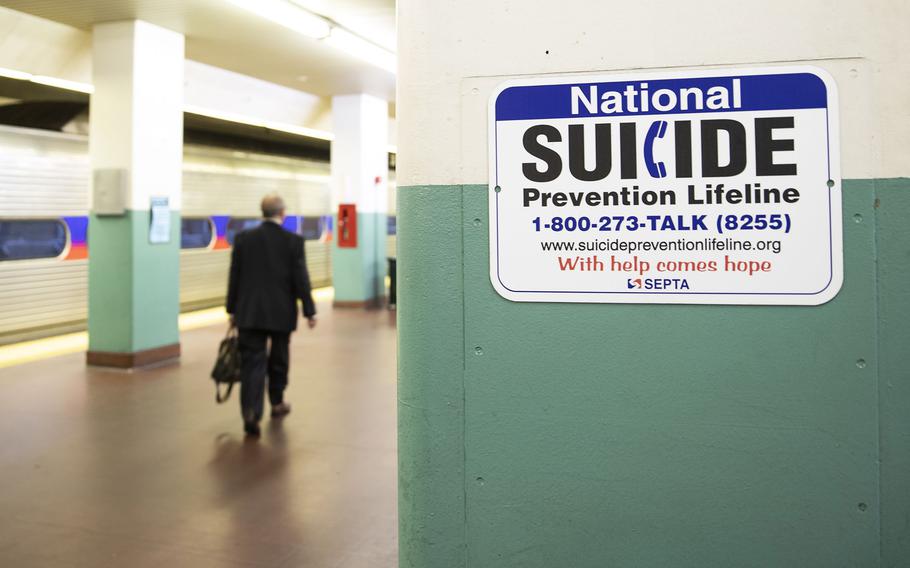
A sign for suicide prevention, photographed on the train platform at Suburban Station in Center City Philadelphia on Oct. 31, 2019. (Heather Khalifa, The Philadelphia Inquirer/TNS)
(Tribune News Service) — “You can prevent suicide.”
In summer, the sign on my neighbor’s lawn is half hidden by flowering bushes, but in the early spring, when suicide rates reach all-time highs, it is visible just a few feet from the street.
Some days I drive out of my way to ignore it. Other days, I purposely drive past it.
Whether I avoid or confront it, the sign’s deceptively simplistic solution leaves me frustrated. It seems to imply that my family and I could have — should have — prevented my father’s suicide.
We couldn’t.
Like many people who choose suicide, my father hid his intentions from his family, partners and friends. He was, everyone agreed, not the type of man to end his own life. And yet on a beautiful spring day in 1987, he did just that.
My family’s experience is not unique. The Centers for Disease Control and Prevention estimates that an American chooses suicide roughly every 11 minutes. Over 50% of Americans will experience the suicide of a relative or close friend. Contrary to popular belief, those who are determined to end their lives often do so, even in the face of sustained efforts at prevention. Just as the causes of suicide are varied and complex, so, too, are the factors that shape our ability to prevent it.
The events in my own family illustrate the difficulties inherent in preventing suicide.
My father’s decision to end his life was a calculated one. He carefully planned his death. He chose a time when my mother was out of town. He opted to do this after I, his youngest child, had left home for college.
The bridge from which he leapt allowed for no easy rescue. And he filled his pockets with rocks to ensure that death would be inevitable. This was not, as some suicide attempts might be, a call for help. It was a final decision from which there could be no turning back.
In researching my family’s long and complicated history of suicide, I have seen a similar pattern play out over and over. Like my father, my great-grandfather and great-great-grandfather also chose to end their own lives. As physicians, both men knew, and used, the exact dose of morphine necessary to ensure that there would be no turning back from death. The more I look at my family’s multigenerational history of suicide, the more I struggle with the difficulties inherent in suicide prevention. I may never know exactly what led to my father’s or ancestors’ actions so many years ago, but I know that what led them there must have been an excruciating pain.
On some days, I fantasize about stopping my father. On other days, I recognize the power of the pain that drove him to the bridge. On most days, I do both — imagine a life in which he did not choose to end his life and imagine a life in which I am at peace with his decision.
Even as I mentally rewrite the events that occurred on that spring day so many years ago, I know that depression can be as difficult to treat as cancer. And like cancer, it can return. Again and again. Peppy drug ads may assure us of the contrary, but the truth is depression sometimes defies treatment.
Decades after my father’s death, depression remains misunderstood among the general public, which makes individuals reluctant to ask for help. This is especially true for middle-aged men, who have the highest suicide rate of any demographic.
Despite my family’s long history of suicide and depression, I don’t have any simple answers about how we should think about suicide and suicide prevention. There is, however, one thing I do know. If we are serious about preventing suicide, we may want to begin with an understanding that individuals alone can’t always prevent suicide.
This is especially important for relatives and close friends of people who die by suicide to hear. This is, after all, a demographic also at higher risk of suicide. Telling them that they can, and should have, prevented a suicide will only exacerbate the depression and suicidal thoughts they experience in the wake of a suicide.
But all that may be too much for a yard sign.
Alexandra M. Lord is a historian who has written extensively about medicine and taboos. She is currently researching and writing a book about suicide in America over the past 120 years.
©2023 The Baltimore Sun.
Visit at baltimoresun.com.
Distributed by Tribune Content Agency, LLC.